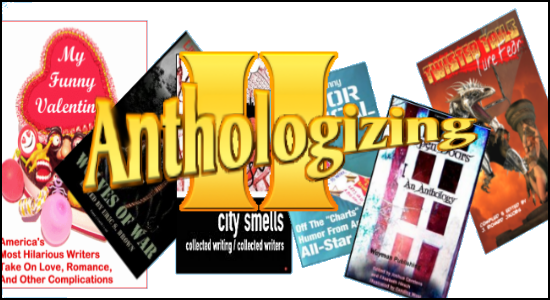
Last month I posted on the use of anthologies–book length collections of writing by several writers–as an optimal way for writers to break in, build “platform”, and promote their work and brand. This week I’ll examine it from the other side: the publishers, editors, curators, or whatever you want to call people who conceive, collect, and produce anthologies.
There are advantages to the “supply side” of this literary format, as well as the submission end. Hey, it’s a publication credit where somebody else provides all the content. It can help establish you as an editor and publisher in a pretty graphic way. There are few better ways to establish contacts with writers in a given field: not only by posting general calls for submission, but also as a “license” to contact writers of more prestige and request the honor. It’s an excellent promotional vehicle: just as you provide a boost to the various writers by the work of creating the book, you–and your line or imprint–benefit from their combined promotional efforts…and you can advertise your other works in the back pages. It’s a powerful tool for charities, causes, or communities: a large percentage of multi-author collections come out under some collective aegis such as a church, writer website, academic department, or cause like AIDS awareness or Breast Cancer prevention or Humane Society outreach.
It’s also a lot of work for the compiler, and often a pain in butt: hassling permissions, herding cats, and coming to grips with multiple demands. So here are some pointers on how to do it right. Who am I to give tips on this? Well, who do you have to be? A large percentage of anthologies are put together by newbies who don’t really get it. There aren’t really any exams or certificates. I say that speaking not as a professional anthologist, exactly, but from experience. I have edited newspapers and magazines, several literary collections from schools and my own enterprises. In the past year I have produced two humor anthologies, “My Funny Valentine” and “My Funny Major Medical”, both of them with decent sales and good regard from their contributors and reviewers. I may do another one when I recover from that butt pain I mentioned earlier. I own the “Anthologists” groups on Linked-In and FaceBook: new groups, but getting some good input from various producers: a good place to give tips and ask questions if this interests you.
Here are some issues worth thinking about (or letting me think about them for you.)
 WHO GETS THE MONEY?
WHO GETS THE MONEY?
I recently posted that I had reservations about a Bukowski tribute anthology I was interested in because they said they would split all revenues among writers, paying quarterly royalties. A huge badge, to me, of people who have not done it before and might not really know what they’re up to. We’re all comfortable with the idea that royalties are the mark of “professional” treatment of writers, and we’re getting screwed if the publishers don’t share the wealth. But once you have 40-80 writers–or more–involved, that becomes a drain, and so unworkable as to be suspicious. Just think about getting quarterly royalties from Kindle and CreateSpace, deducting your own cut, then carving up the rest to send to all those authors. And that’s not even mentioning things like taxes.
So what are better models? First, lump sum. You pay them once and that’s it. How much? Actually, $20-50 is the most common sum. Writers don’t object to those numbers. Big books from big publishers might pay as high as $200 (Chicken Soup pays that, and 10 comp copies). That’s the highest I’ve seen. Trouble is, multiply even $50 by 50 writers and you have a $2500 “nut” to crack–no easy task for an indie book. And you have to pay it up front. Seeing that sort of payment model either means that the publishers are doing this on an ongoing, successful scale… or that they have more money than good sense.
Another very common method is to donate the proceeds to charity. An obvious choice for “service” anthologies like I mentioned, but actually a useful dodge for small or beginning projects. Very simple to deal with, tax free, one check/PayPal. And acceptable. Writers generally don’t have a problem with this. In fact, they tend to applaud it.
Screw ’em. Don’t give them anything. This has been my own practice with the anthologies I mentioned. Of course, I’m a jerk, but there are also good reasons behind this. The whole precept of that line is “driven by promotion, not profit”. This is explained at length in the submissions FAQ. Very simple accounting. And writers have enthusiastically accepted it. And the better, or more professionally advanced, the writer is, the more they immediately understand the advantages in getting not just the credit, but the promo for their other books or projects. Promotion is pointless for writers who don’t have a book out to promote. But those with no track record like the idea of getting started. So you don’t really have to pay to make it worthwhile and fair for writers to contribute for free–what you need to do is a good job of presenting the work and getting it in front of readers. So what happened to the profits on the My Funny books? Other than me blowing them on expensive intoxicants and cheap women? So far not that much. It’s an advertising fund we’re still learning how to use. And the more ads and promotion, the better it works. Even diverting some to other projects or personal use isn’t exactly evil. Editors do a lot of work on these things. A LOT of work. It’s always way more than you thought it would be. The writers, on the other hand, generally had already written, even published, their contributions, or had plans to use them in their own projects in the future. Very little effort involved, no expense. They can promote as much or little as they feel like and benefit directly from whatever they put into it. So it’s fair. And accepted. IF you are trusted and live up to your end of the bargain: that their work appears in something they can be proud of and it’s out there harvesting eyeballs for them.
 HOW MUCH DO YOU OWN?
HOW MUCH DO YOU OWN?
Which leads directly to another issue many producers don’t understand. They follow the lead of “big house” imprints and don’t want previously published work, don’t want the writers to be able to use it again, at least for a period of time or with restrictions or permissions required. This is a huge mistake. For one thing, it turns the project into something a writer has to work on. Maybe it’s a labor of love, and they are ecstatic at the opportunity of writing a piece of satire on sexual perversions in the Star Wars films, but it makes things a little different if they are giving up rights. Or if they can’t send in some great item they ran in a local or university journal a few years ago. Which, when you think about it, is exactly what you should want: their best work. Funny Books considered that the best provenance a piece could have would be a prior or future publication in a good book. This multiplies the whole promotional aspect of the thing. But just think of it like this. What would you rather have in your book, something I whipped off for your deadline, or a short story Steven King wrote for some defunct horror magazine and for some reason will let you run? My policy is to take the best stuff I can get, and actively search for existing material by good, and known, contributors, then to place no restrictions on future use, other than mentioning that it appeared in my book first. Why wouldn’t you want a piece out there in another book with a link or mention of yours?
 CURB APPEAL
CURB APPEAL
I am frequently shocked at how lousy so many anthology covers are: even books I like and was happy to be included in. Look down my Amazon page at the four collections other than Funny Books that I appear in. See any covers that just grab your eye to open them? And those aren’t even actually bad ones. Poke around some of the horror and SF collections to see some major fails. This is a critical element. Part of that pledge to the writers. They deserve being in an attractive book. I spent a huge amount of time doing the My Funny covers because it had to be done.
By the same token, editing must be competently done, absolutely. Again, big work for the producer. But the multi-writer situation, although it increases all the hassle of dealing with writers, can also have advantages here. Sending early copies to everybody can reap corrections from many: again, it’s to their advantage to have the book clean as possible. In a move I think is somewhat innovative, I had a KDP “free day” for Major Medical immediately, but announced it only to contributors and some reviewers. This meant that everybody had an ebook, immediately, and could notify their friends and family to download it for free. A source of good will, potential for increasing paperback sales, and garnered a lot of embarrassing typo-spotting, which benefited the work. And, let me point out, editing is another advantage to using previously published work.
Another place I see anthologies failing is the matter of “up front”. This has been a matter of discussion on the LinkedIn group: what goes in the first pages. My feeling is that the most important consideration is the “Look Inside” feature on Amazon. This sample of your wares is a valuable resource that you need to take full advantage of. We’ve all seen books where you end up sampling page after page of blurbs by nobodies, Creative Commons boilerplate, interminable copyright rants, annotated table of contents… then get to see a couple of pages of the work we are trying to decide to buy. You need to optimize for this feature, especially in the ebook version. The front of the book is no place for all that copyright crap. My only consideration of sequencing of stories was to select shorter pieces that got to the funny immediately, rather than a slow build-up. I wanted to show as much variety as I could, and have it very accessible. All writer bios are at the back of the book in one section.
That’s probably the biggest difference of opinion among publishers: where to put bios. I’ve actually seen the book lead off with all the bios. That’s crazy. Unless they’re a cavalcade of famous names, you don’t want to waste valuable space with that. Some like to have the bios with the work, either leading or after. That’s probably legitimate, but I can’t see it. The bios aren’t going to sell the book, and they don’t help people decide if they’ll like it. Getting them laughing (or creeped out, or horny, or speechless in admiration, or whatever) right off the bat is the hot ticket.
One thing VERY important for anthologies: much of the motivation of many writers is getting the book “claimed” on their Amazon author page. Not everybody can get listed on the book’s page, so you want to make it easy for them to tell Amazon to list the book. And the easiest way to do that is for their name to be right up front on the “Look Inside”. This is also their “proof credit” for agents or whoever they want to show it to.
By the way, all Funny Books writers also have much more extensive bio information with live links on the website itself.
 HERDING THOSE CATS
HERDING THOSE CATS
It should be obvious that having 40 writers (and choosing them from hundreds of applicants) dramatically increases all the housekeeping and bookwork. There is always one more who didn’t get the word, who didn’t send in their release form, who has another question or suggestion. You can greatly reduce your head-banging and hair-tearing by organization. There are many ways to skin that cat, but I will continue to lavish my hard-won, invaluable trade secrets on you here by revealing the way we handle the biggest task–selection. It’s no joke having to read 300 stories, then take the 30 or 50 best. You end up reading them more than once, to say the least. Here’s how we did it.
We lucked out in choosing Gmail to set up our submission address. Using your own address would be insane, by the way. Gmail allows “tagging” of mail with colored tabs that can be sorted by tag–showing you a list of all the mail with a single tag, and only those. I was working with Karla Telega, so we had tags that said, Lin Likes, Lin Hates, Karla Likes, Karla Hates. A lot of stuff you read is just immediately obvious as a stinker or a star. (Too bad they aren’t all so immediately obvious, but that’s life.) Three more tags were “Accept”, “Reject”, and “Bubble”. “Hates” were pretty automatically changed to “Reject”, although one, maybe two got resurrected if the other readers liked them. A few “Likes” got bumped, but most got their tag changed to “Accept”. At a later point in the process, most were either accepted or rejected, with some in the “Bubble” zone. Thing is, you generally have some sort of length parameter. It might be that you can only afford to pay and comp X number of writers. It might be that you’ve decided on a page length limit (high and/or low). If your acceptees don’t fill you up soon, you end up sorting through those “on the bubble” to see if something might do. In two cases the writers of “bubbles” were asked to change their submission to fit and both were happy to.
Once the “Accept” and “Reject” lists are compiled you can easily send out notices, as well as further announcements and contacts, to The Chosen. These tagged lists can also be exported for other mailers. Notice this handles things without the need of other charts or file cards or anything. Just keeping tags straight on your mailbox.
I’m running long on this, but if anybody is interested in doing an anthology and has further questions, join the Linked In group and ask away, or send me mail.

Lots of great advice and interesting ideas.
Enlightening. Thanks.
Yes, you must, must MUST claim that book on your Amazon author’s page. Last year I made it (albeit for only a short time) into Amazon’s Top 100 horror ebook authors on the strength of one anthology to which I had contributed having a strong run on sales over a 99 cent promotional weekend.
Hey, it all counts. 🙂
Interesting ideas, Lin, thanks.
Thanks everybody. Hope this stuff is useful to you.
Great article, Lin, much appreciate both of the choc-o-block full of information posts; information garnered and stored for future use.
Well, you know what a slave-driver Stephen is. You gotta deliver if you’re not going to get minion-outsourced.
Let me pass on an answer to a question this raised on LInked In. About themed anthologies and specific a theme can get.
The narrower a theme gets, the more it’s a “niche”.
And niches cut both ways. It’s easier to reach a focused audience like that. BUT, it limits your sales potential.
SF is too broad to even be considered thematic. Sex in SF is going to be easier to do something with. Transexuals in SF is going to do really well with a very tiny audience.
And another thing to consider–how about the writers? I wanted to do something on cruise ship humor, get into the distributors for onboard bookstores with a captive, moneyed , bored clientele. Trouble is, I figured out there just weren’t enough writers I could contact who’d been on cruises.
lol Writers can’t afford cruises.
Exactly. Maybe as deckhands or stowaways.
I worked on board a cruise ship for a month – the SS Chusan, a P&O liner. We cruised from Southampton, north to Amsterdam, Copenhagen, Narvik and around the Norwegian Fjords; we stopped at one or two more ports on the way up to North Cape (during the time of the midnight sun). Returning to Southampton, we went south to Tenerife and around the Canary Islands, Vigo (Northern Spain), Lisbon (Portugal) and Casablanca. I was working but I had an outrageous time! However, that was forty years ago, Lin!
Awesome. I’m “The Chosen.” That rocks…
Actually, we just let you in because we felt sorry for you. 🙂